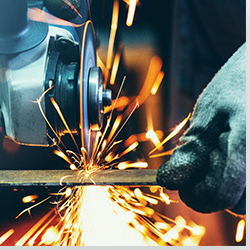Sharp tools and materials are commonly found on building sites, in workshops, and in a range of other workplaces. They present a real threat to the safety of workers, as it only takes a simple mistake to cause a serious cut, which then has the chance of becoming infected if not treated properly.
Wherever workers are exposed to sharp tools or materials, it’s essential that cut-resistant gloves are available that are comfortable, durable, and fit for purpose.
A Guide To Cut Resistant Gloves
Sharp tools and materials are commonplace within a range of workspaces, such as warehouses, workshops, facilities, building sites and more. If your employees work around such objects in any capacity, it's important that you familiarise yourself with the risks that they present you - and that you make sure your employees are equipped with the right PPE to prevent serious injuries.
Wherever workers are exposed to sharp tools or materials, it's essential that cut resistant gloves are made available and they are comfortable, durable and fit for purpose.
Complications of cuts from sharp objects
Cuts, specifically to the hands, fingers and wrists, are some of the most common occupational injuries in the UK every year. A cut of any severity could lead to serious complications, including:
- Infections
- Sepsis
- Nerve damage
- External and/or internal bleeding
- Permanent scarring
It is therefore paramount that employers protect workers who are at risk from injury as a result of handling sharp blades or tools, operating power tools or coming into contact with sharp materials.
Why wear cut resistant gloves?
Unfortunately, completely cut-proof gloves haven't yet been developed. However, innovations in technology and materials such as Kevlar, glass fibre and polyurethane mean that cut-resistant gloves can help to significantly reduce the risks presented by sharp materials in the workplace, ensuring that workers can carry out their jobs safely.
Common industries where employees should have access to cut resistant work gloves include:
- Construction
- Mechanical maintenance
- Engineering
- Agriculture
Levels of cut resistance
The level of protection required in a workplace where cut hazards are present can be measured on a scale of 1-5, with different severities of danger dictating what level of protection is required.
| Risk level |
Hazard |
Industries at risk (examples) |
| 1 |
Nuisance cuts |
Car maintenance, parts assembly, packaging |
| 2 |
Low-risk cut hazards |
Construction, masonry, joinery |
| 3 |
Moderate cut hazards |
Light metal stamping, agriculture |
| 4 |
High cut hazards |
Sheet metal handling, glass handling, food service |
| 5 |
Extreme cut hazards |
Heavy metal stamping, food preparation |
Employers should select the appropriate cut resistant work gloves depending on the level of risk present in their workplace. From lowest level of protection to highest, strength of gloves may be made from:
- Latex
- Leather
- Cotton
- Synthetics (nylon, etc)
- Engineered yarns (Kevlar, etc.)
- Metal mesh
Employer responsibilities
According to the Pesonal Protective Equipment at Work Regulations 1992, if there is a risk of injury in a workplace which could be avoided with the use of Personal Protetive Equipment (PPE), then employers are required to provide suitable protective equipment from their employees.
This means that PPE - such as cut resistant work gloves - should always be provided when there is a risk of injury from sharp tools, materials or objects,. Employers are also required according to the regulations to replace protective workwear as needed, whether they have been lost, damaged or simply worn down.
Employers should take responsibility to provide PPE seriously, ensuring that the appropriate cut resistant gloves are available in any working environment where sharp tools and materials are used, or even present.
Safety standard for cut resistant gloves
The EN 388:2003 European Standard applies to all forms of hand protection which protect against abrasion, blade cuts, punctures and tearing from mechanical risks. It sets out requirement including test methods and labelling that must be supplied with protective gloves. This standard means that a four-digit code must be displayed on the packaging of all cut resistant hand protection.
Each number in the code refers to the product's ability to perform in one of four areas:
- Resistance to abrasion (0-4)
- Blade cut resistance (0-5)
- Tear resistance (0-4)
- Puncture resistance (0-4)
All protective gloves are also bound by EN 420, which sets our requirements that gloves must meet in order to be deemed fit for purpose. Requirements are outlined regarding the dexterity that work gloves should allow, sizes that should be covered and information that must be on the packaging of the gloves.
Cut resistant gloves with Protec Direct
Browse our complete selection of cut resistant gloves today or explore our wider range of hand protection to find gloves suited to dozens of purposes and industries such as anti-vibration gloves, builders grip gloves and much more.





Leave a comment